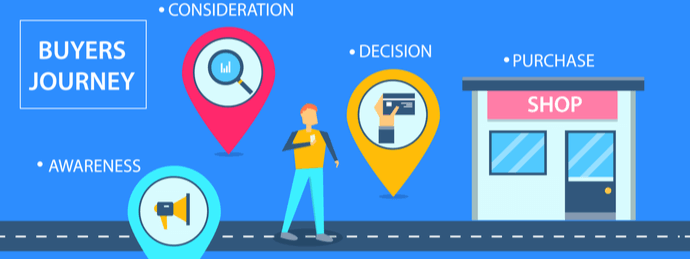Marketing success depends on many factors. It takes a lot to execute brand strategy, content strategy, and production. Even though you have a grand plan for how you’re going to make it all happen, you must never forget one thing: your metrics.
Your hard work will be wasted if you do not have metrics (or a framework for defining metrics). There’s no way to find out what’s working, what’s not, how to fix your marketing or improve it, or how to justify your decisions to higher-ups. It’s not just about having metrics; it’s about choosing the right ones.
What is the Buyer’s Journey?
Content types can be difficult to determine. The concept of the buyer’s journey will help you become a more effective digital marketer once you understand how to incorporate it into your content strategy.
The buyer’s journey describes how someone discovers a problem, researches it, and finally purchases a product to solve it.
Based on that definition, the buyer’s journey can be divided into three stages: awareness, consideration, and decision.
What Buyer’s Journey Benchmarks Reveal
There is no longer a straight line between discovery and conversion in the B2B buyer’s journey. There is more information available to B2B buyers than ever before – and that isn’t always a good thing.
In addition to the buyer’s journey, buyers can be overwhelmed by the amount of information and options available online. Buyers’ journeys often loop and repeat, like this:
The number of channels and repeating loops makes it more likely than ever for buyers to drop out of the buying journey, which costs brands millions of dollars in lost sales.
The measurement of buyer journey benchmarks throughout the buyer journey allows businesses to understand where buyers are falling out of the funnel – and offers key insights into how to keep them there. Most B2B marketers don’t track the right benchmarks.
Choosing Key Metrics to Understand the Buyer’s Journey
-
Consideration
Engaging your target audience with brand content will help you create a demand for your brand. Again, you can accomplish this with posts, but go one step further and respond to people’s comments.
Remember that engagement is a two-way street, so keep the conversation going. Look at the number and type of engagements to determine success.
Did your posts receive many comments? How many shares and likes did you receive? Last but not least, make sure you know how many people visited your business.
-
Awareness
Getting your brand in front of prospective customers is your first objective. Brand content is one way to do this. A brand’s activity metrics include posts on its social media timeline and paid boosts to gain more traction.
You can measure success by looking at impressions and reach statistics. Those with the highest impressions will see your posts more often. As your reach increases, your post gets exposed to a wider network.
-
Decision
A lead is worthless if it does not turn into a sale. Use targeted offers to drive conversions. Offer people an offer they can’t refuse. Your key performance indicators (KPIs) for these activities are the link clicks on your social media posts – if people click, they’re serious about buying, signing up, or taking advantage of a trial.
Analyze your business’s impact by counting conversions, which can include purchases, subscriptions, downloads, etc. You can track your links so you can follow a social media share through to a purchase made on your site or a form filled out.
-
Adoption
Now that you have the customer, you want them to come back again. For this goal, post-sale customer service is the best strategy. Your brand can drive engagement with its products or services on social media.
Online responses to customer questions and complaints are crucial for social customer care, and they can be measured by the response time, response quantity, and positive mentions from satisfied customers. Customer satisfaction impacts business sentiment positively.
-
Advocacy
Last but not least, you want repeat customers to become brand advocates. Are any of your customers willing to write a review or testimonial or post a post on social media about their experience with you?
Engage customer influencers with posts, reshares, and outreach to get better and wider-reaching results.
Utilize the earned impressions and earned reach generated by social sharing, media coverage, or any other third-party involvement to measure the success of these activities.
Conclusion
The buyer’s journey is complex, which makes it hard to figure out where your sales and marketing processes are failing.
To track success, it is essential to track metrics. Tracking the right benchmarks at each stage of the buyer’s journey can help you understand which measures are effective, and which aren’t.

